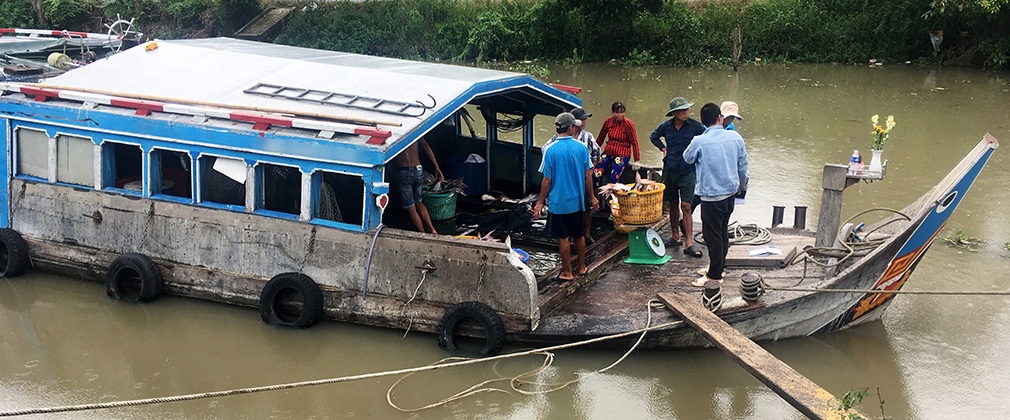Pangasius Farming on the Mekong River
VIETNAM—July 2019. “The Mekong River is the heart and arteries of the region,” says researcher Dave Love. “All business is conducted on the river. The feed comes in by boat. The fish go out by boat. Everything you want to do is done by boat and motor bike.”
Love, an associate scientist at the Johns Hopkins Center for a Livable Future, traveled to Vietnam in July and August (2019) to learn more about how Vietnamese farmers raise Pangasius, a species of catfish. Vietnam is the epicenter of Pangasius production, and it has been the largest exporter of catfish to the United States, although an ongoing trade dispute is changing that. He and research partners Mark Brown and Ly Nguyen from the University of Florida met with farmers and other industry stakeholders to gather data about how the farmers use energy, how they use resources and what kind of waste is created in the operations. Giap Nguyen from University Economics Ho Chi Minh City worked alongside Love, Brown and Ly Nguyen as a translator.
This investigation is one piece of a larger study of seafood waste and resource use, funded by the US Department of Agriculture National Institute of Food and Agriculture. The ultimate goal of the research is to identify opportunities to increase efficiency. Love, Brown and Nguyen hope they can find ways to help the Pangasius farmers become more energy- and water-efficient and reduce waste, ultimately helping the them to become more profitable and serve as stewards of their natural resources.
Love and Brown conducted their research by meeting with farmers and with local government officials involved in the industry, and by having them fill out a questionnaire for data collection. The farmers they met with on this trip were all export-oriented. “A typical meeting with a farmer in Vietnam took place at a coffee shop in the morning before work,” says Love, “or at the farm at lunch break or at their house in evening.”
The sectors that the research is exploring include feed companies; processing plants; hatcheries; and farming. Love and team are investigating how energy is used in each of these sectors, as well as how natural resources are used and where waste is created. The Mekong river water is pumped into farms and some hatcheries, and returned to the river after it is used. Many businesses expressed an interest in becoming more energy efficient, including switching to energy efficient lightbulbs, installing solar photovoltaic cells and using energy at off-peak hours (with lower utility rates).
The team hopes to find ways to boost efficiency within each industry. For example, one Pangasius farmer may have a more efficient method than another Pangasius farmer in the same region—those comparisons are what the researchers seek.
While on the Mekong, Love learned that catfish production is attractive to farmers for several reasons: it’s more land-efficient than rice production, and there’s a lot less manual labor involved than in rice. “The catfish pond seems like an easier business model,” says Love.
The farmers impressed upon him how much their prosperity depends on the price of fish.
Vietnamese catfish farmers reported to Love that they don’t receive a lot of government support. “If they have a problem, they have to solve it themselves,” he says. This is an important piece of information, because the farmers might have innovations that other farmers don’t know about. If the research brings innovations or challenges to light, those ideas can be shared or built upon with additional work. Even just raising awareness would be a benefit of this research.
The research will be underway until 2020, and data will be analyzed by collaborators based in Florida and Italy. The team expects findings by 2021.
The USDA study is funded through the Innovations at the Nexus of Food, Energy and Water Systems (INFEWS) Initiative. For more information about the INFEWS project, click here.
To read about Atlantic salmon farming in Norway (another part of the INFEWS project), click here.
